The Skincare Oil Market is estimated to be valued at USD 21.2 billion in 2025 and is projected to reach USD 39.0 billion by 2035, registering a compound annual growth rate (CAGR) of 6.2% over the forecast period.
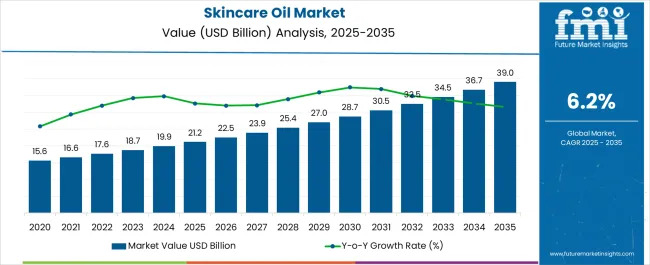
| Metric | Value |
|---|---|
| Skincare Oil Market Estimated Value in (2025 E) | USD 21.2 billion |
| Skincare Oil Market Forecast Value in (2035 F) | USD 39.0 billion |
| Forecast CAGR (2025 to 2035) | 6.2% |
The skincare oil market is experiencing strong growth, fueled by increasing consumer awareness of natural formulations, rising disposable incomes, and heightened focus on personal wellness. Oils are being embraced for their multifunctional properties, offering hydration, nourishment, and protection against environmental stressors.
The market is supported by the expansion of clean beauty trends and a shift toward products free from synthetic chemicals. Demand is also being influenced by the growing popularity of holistic skincare routines that integrate traditional and botanical-based oils.
Global e-commerce platforms have broadened accessibility, making niche and premium brands available to a wider consumer base. With consistent innovation in blends and enhanced formulations, the market outlook remains positive, supported by consumer demand for safe, effective, and sustainable skincare solutions.
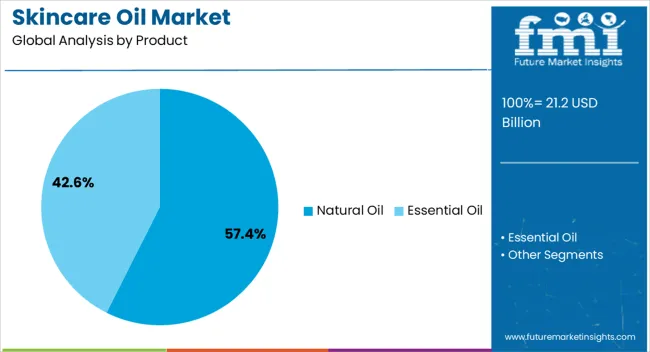
The natural oil segment leads the product category in the skincare oil market, holding approximately 57.4% share. Its dominance is attributed to the growing consumer preference for plant-based and organic solutions aligned with clean beauty movements.
Natural oils such as argan, jojoba, and rosehip are valued for their high nutrient density and compatibility with diverse skin types. Rising awareness of the harmful effects of synthetic chemicals has further reinforced adoption.
The segment benefits from broad distribution across both mass-market and premium channels, as well as versatility in application ranging from moisturization to anti-aging solutions. With expanding product availability and consistent consumer trust in botanical formulations, the natural oil segment is expected to sustain its market leadership.
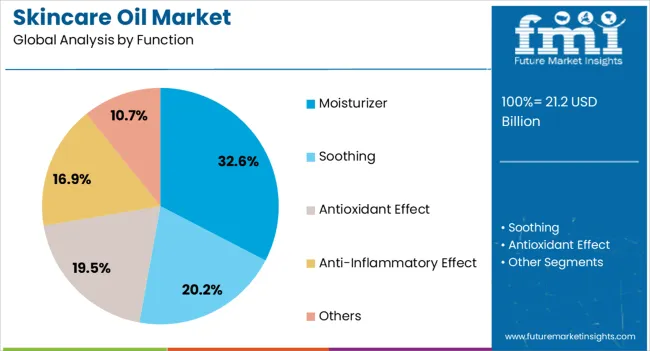
The moisturizer segment dominates the function category, holding approximately 32.6% share of the skincare oil market. Oils formulated as moisturizers are preferred for their ability to create a protective barrier, retain hydration, and improve overall skin texture.
This segment’s growth has been driven by increasing awareness of skin health, rising prevalence of dryness-related conditions, and the popularity of natural moisturizing solutions. Consumer interest in lightweight, fast-absorbing oils has further fueled demand.
With innovation in blended oils targeting specific skin concerns, the segment has broadened its consumer base across various demographics. The functional effectiveness of oils as moisturizers ensures consistent adoption, positioning this segment for continued growth.
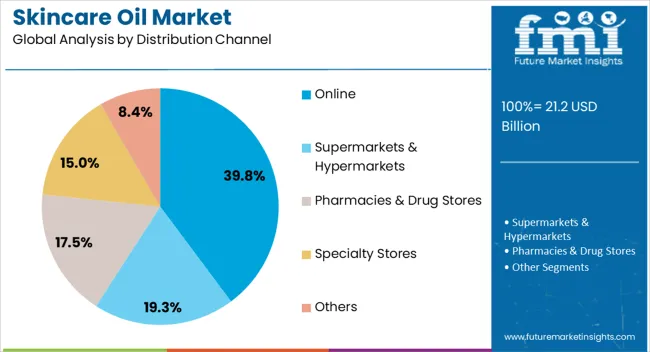
The online distribution channel accounts for approximately 39.8% share of the skincare oil market, reflecting the growing dominance of e-commerce platforms in beauty and personal care. Online channels provide consumers with access to a wide range of brands, reviews, and product comparisons, influencing purchasing decisions.
Digital marketing campaigns, influencer endorsements, and subscription models have significantly boosted sales in this category. Cross-border e-commerce has further enabled the global reach of niche and premium skincare oil brands.
Convenience, home delivery, and competitive pricing continue to attract consumers toward online channels. With digitalization trends accelerating and consumers increasingly shifting to online shopping, this segment is expected to maintain its upward trajectory.
The market for skincare oil has grown at a CAGR of 5% from 2020 to 2025, driven by the presence of multiple key players in the market, the rising cases of diabetes, thyroid, and kidney disease, which bring dryness to the skin, and with it and rising aging population. In 2025, the market for skincare oil represented 35.3% of the total global cosmetic oil market of USD 53.6 billion.
The skincare oil industry is getting moisturized due to the growing demand for bio-oils that can prevent acne and reduce inflammation. The increasing attraction toward premium products due to their packaging further gives them an edge-cutting look over others.
Sensitive skin conditions are also a key concern among the population, which fuels the demand for organic and herbal products. The key manufacturers are bringing in new products that contain no to less harmful chemicals or ingredients. Moreover, several manufacturers have started reformulation of the products to make them more authentic for eco-conscious consumers.
For instance, in August 2024, Bio Oil’s skincare oil was reformulated entirely with 100% plant oil extract. Similarly, many other manufacturers are shifting from inorganic to organic ingredients. The increasing availability of resources is making the population concerned regarding the ingredients used; thus, manufacturers are now transparent about the ingredients.
Manufacturers are offering products that can be used by all skin types and come up with solutions for people with seasonal skin allergies. Thus, owing to the factors mentioned above, the global skincare oil market is projected to grow at a rate of 6.3% during the forecast period.
Consumers are increasingly seeking natural and organic skincare products, including skincare oils, due to concerns about the potential adverse effects of synthetic ingredients. This trend presents an opportunity for companies to offer high-quality and organic skincare oils.
Plant-based skincare oils, such as argan oil, jojoba oil, and rosehip oil, have gained popularity due to their natural properties and potential benefits for the skin. Companies can capitalize on this trend by offering a diverse range of plant-based skincare oils. The advancing skincare care industry and manufacturers developing organic products are presenting growth opportunities for new and established market players.
The rise in environmental changes is also worsening the weather conditions. The sudden changes in the environment due to global warming make the weather extremely cold and extremely hotter than the usual conditions. This range of temperature impacts the skin and makes it dry. Thus, the rise in temperature fluctuation is increasing the demand for skincare oil.
The high price of premium and branded products to maintain its standard restrains the market growth. Moreover, the pricey products designed for certain skin types, allergies, and weather may impact the market growth.
The chemicals used in the manufacturing of essential oils can cause specific skin issues and damage the skin. Some chemicals can be phototoxic, which can cause reactions when exposed to sun UV rays. Also, some oils can cause irritation or a burning sensation for sensitive skin types.
As per analysis, North America recorded a significant growth in the skincare oil industry, followed by Latin America, during the historical period. However, the market in the United Kingdom and Germany is likely to experience notable growth due to growing awareness of both men and women toward night skincare routine.
| Countries | CAGR |
|---|---|
| The United Kingdom | 5.5% |
| Germany | 5.9% |
| China | 7.8% |
| Japan | 5.1% |
| France | 3.0% |
The United Kingdom held a significant market share globally. The skincare oil market in the United Kingdom recorded a growth of 6.5% in 2025 and is likely to capture a CAGR of 5.5% in 2025.
Concerns about the potential adverse effects of synthetic ingredients drive the growing trend toward natural and clean beauty products in the country. Skincare oils, especially those derived from natural plant sources, are seen as safe and effective alternatives, contributing to market growth.
The influence of social media platforms and digital marketing has had a significant impact on the skincare industry, including skincare oils. Influencers, beauty bloggers, and online skincare communities share information and recommendations about skincare oils, creating awareness and driving demand among their followers.
In 2025, the market for skincare oil in China is estimated to register a growth of 7.8%. The country's demand for and sales of beauty oils has been supported by the country's growing young population and rising female engagement in the workforce. Additionally, as customer desire for natural products has increased, so has the understanding of the myriad negative impacts of synthetic items.
Chinese consumers are ready to spend more than their Asian counterparts on organic beauty products, which has greatly benefited the market for skincare oils. Moreover, the popularity of skincare oils is growing in the nation as a result of local manufacturer’s diverse product offerings.
In 2025, the market for skincare oil in Germany is anticipated to evolve at a CAGR of 5.9%. German consumers are increasingly concerned about the ingredients used in skincare products and are seeking natural and organic alternatives.
Skincare oils, especially those derived from natural plant sources and certified organic, are in high demand due to their perceived purity and effectiveness.
The essential skincare oil dominated the global market with a value share of around 62.0% in 2025 and is anticipated to grow at a rate of 7.3% in the forecast period.
| Product | Essential Oil |
|---|---|
| CAGR | 7.3% |
The cosmetic business relies heavily on essential oils because they not only give products nice smells but also act as preservatives and active ingredients while also providing the skin with several health benefits. Thus, the segment is anticipated to have a command of the market in the forecasted period.
Moisturizing function is highly preferred in the skincare oil market, accounting for 28.9% market share in 2025.
| Function | Moisturizing |
|---|---|
| CAGR | 8.8% |
The skincare oils penetrate deeply into the skin, retaining moisture and avoiding dryness. This results in long-lasting hydration. As a result, it assures that the skin's barrier will keep everything inside and that the water content of the skin won't be lost. Therefore, it is typically preferred to use skincare oils as moisturizers.
The supermarkets & hypermarkets segment accounted for 37.7% in 2025 globally in terms of value share, and it is predicted to have a hold on the market over the forecast period.
| Distribution Channel | Supermarkets & Hypermarkets |
|---|---|
| CAGR | 8.0% |
Supermarkets and hypermarkets provide customers with an opportunity to select the product they want to have from several available options. They get a chance to check the products, verify their quality, and compare the prices with other brands. Additionally, supermarkets and hypermarkets provide customers with discounts that lower the product's price. Thus, it is the broadly preferred segment by customers.
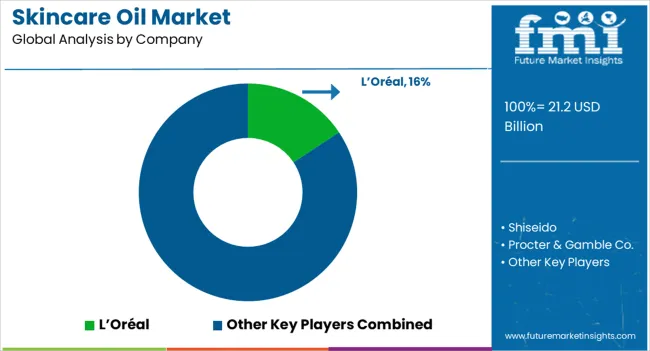
To build a position in the industry, the key skincare oil brands are largely focusing on boosting their market share and product supply. Top producers like Shiseido and Blueskys use strategic tactics like collaboration and expansion to increase the supply of skincare oil.
| Attribute | Details |
|---|---|
| Forecast Period | 2025 to 2035 |
| Historical Data Available for | 2020 to 2025 |
| Market Analysis | USD billion for Value |
| Key Regions Covered | North America, Latin America, Europe, South Asia, East Asia, Oceania, and Middle East & Africa |
| Key Countries Covered | The United States, Canada, Brazil, Mexico, Argentina, the United Kingdom, Germany, Italy, Russia, Spain, France, BENELUX, India, Thailand, Indonesia, Malaysia, Japan, China, South Korea, Australia, New Zealand, Türkiye, GCC Countries, North Africa and South Africa |
| Key Market Segments Covered | Product, Function, Distribution Channel and Region |
| Key Companies Profiled | Shiseido; Procter & Gamble Co.; Burberry Group Plc.; Unilever; L’Oréal; Beiersdorf AG; Avon Products, Inc.; Estée Lauder Companies; Amway; Chanel S.A.; Johnson & Johnson; Chatters Canada; Kao Corporation; Henkel; Edgewell Personal Care; Markwins Beauty Products; Mary Kay; Coty; Marchesa |
| Pricing | Available upon Request |
The global skincare oil market is estimated to be valued at USD 21.2 billion in 2025.
The market size for the skincare oil market is projected to reach USD 39.0 billion by 2035.
The skincare oil market is expected to grow at a 6.2% CAGR between 2025 and 2035.
The key product types in skincare oil market are natural oil and essential oil.
In terms of function, moisturizer segment to command 32.6% share in the skincare oil market in 2025.






Full Research Suite comprises of:
Market outlook & trends analysis
Interviews & case studies
Strategic recommendations
Vendor profiles & capabilities analysis
5-year forecasts
8 regions and 60+ country-level data splits
Market segment data splits
12 months of continuous data updates
DELIVERED AS:
PDF EXCEL ONLINE
Palm Oil-Free Skincare Market Insights – Trends & Growth 2024-2034
Hemp Oil Infused Skincare Market Size and Share Forecast Outlook 2025 to 2035
Skincare Supplement Market Size and Share Forecast Outlook 2025 to 2035
Skincare Nutritional Serum Market Size and Share Forecast Outlook 2025 to 2035
Skincare Products Market Size and Share Forecast Outlook 2025 to 2035
Skincare Market Analysis - Size, Share, and Forecast Outlook 2025 to 2035
Skincare Packaging Market Size, Share & Forecast 2025 to 2035
Skincare Industry in India – Trends & Growth Forecast 2024-2034
Global Skincare Treatment Market Analysis – Size, Share & Forecast 2024-2034
Global PDRN Skincare Market Size and Share Forecast Outlook 2025 to 2035
Men’s Skincare Products Market Size, Growth, and Forecast for 2025 to 2035
Global Smart Skincare Market Size and Share Forecast Outlook 2025 to 2035
Cooling Skincare Gels Market Size and Share Forecast Outlook 2025 to 2035
Natural Skincare Preservatives Market Analysis - Size and Share Forecast Outlook 2025 to 2035
Ormedic Skincare Market Demand & Insights 2024-2034
Ceramide Skincare Market Size and Share Forecast Outlook 2025 to 2035
BPA-Free Skincare Market Trends – Demand & Forecast 2024-2034
Camellia Skincare & Cosmetics Market
Buffering Skincare Products Market Analysis - Size and Share Forecast Outlook 2025 to 2035
Menopause Skincare Solutions Market Size and Share Forecast Outlook 2025 to 2035

Thank you!
You will receive an email from our Business Development Manager. Please be sure to check your SPAM/JUNK folder too.
Chat With
MaRIA